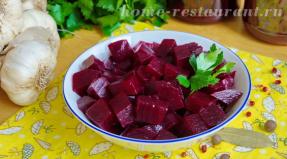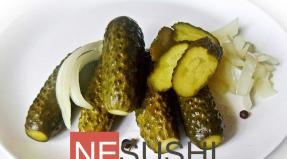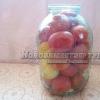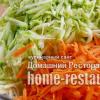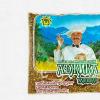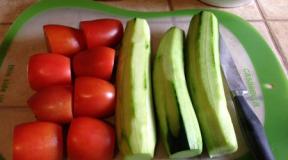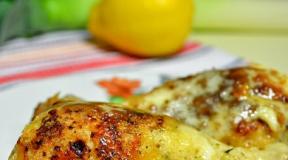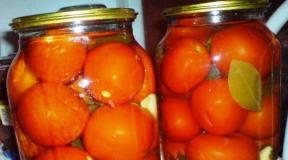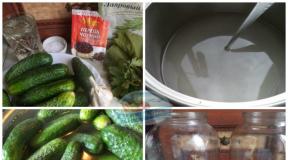The origin of food dyes. What are the dye groups? From the history of dyes
Natural food dyes - easy, environmentally friendly and useful 95% of the information a person perceives with the help of his eyes, and to make the dish brighter means to make it more attractive. So, juicy burgundy color borscht or colorful salad uniquely stimulate the appetite. This is the basis for the demand for food coloring in cooking.
For thousands of years, people have successfully used the gifts of nature, extracting food dyes from them. Now we have incomparably more opportunities for such research - let's see how you can prepare natural food colors at home and what requirements we place on them.
Requirement 1 - Natural Dye
Extremely natural materials - extracts, husks and juices, decoctions and tinctures from seeds and fruits of plants, from leaves and bark. Animal materials are not used for coloring food - because of the bright characteristic taste, because of the difficulty of obtaining and because of the short shelf life.
Requirement 2 — Food Color — Means Edible
This requirement implies not only the edibility of the dye, but also a minimum of its own taste. Ideally, the dye should be completely tasteless (onion peel) or add some raisin (citrus zest or coffee) with the color. The taste of the dye should not affect the taste of the final product, but it is difficult to realize in reality - and a separate task when using natural dyes is the result of mixing tastes and flavors.
Requirement 3 - Coloring Food
To this requirement can be attributed to the durability and immutability of color - at least for a short time, although these parameters natural dyes definitely lose synthetic.
What to cook natural food colors at home
.jpg) The beauty of natural food colors in their availability. These are foods that we eat almost every day, familiar and useful, inexpensive and affordable. Beets, carrots, spinach, spices, bright berries and citrus fruits - this is our rich arsenal at home.
The beauty of natural food colors in their availability. These are foods that we eat almost every day, familiar and useful, inexpensive and affordable. Beets, carrots, spinach, spices, bright berries and citrus fruits - this is our rich arsenal at home.
The answer to the question “what to prepare natural food colors for” is at hand at the hostess in each kitchen.
We can use:
1. Fresh juices from colored products.
2. Ground and roasted their flesh.
3. Direct addition of fresh pulp to the final product.
Feel free to be guided by the original color of the vegetable or fruit: if the beet is dark red, then the dye of the orange or green gamut we can’t get from it. Accordingly, green spinach will not give us a red dye, no matter what we do with it.
However, with natural dyes, the same principles of mixing colors are used as with watercolor, gouache or synthetic dyes. If you want to get an orange dye - mix red and yellow. Need green - mix yellow and blue food coloring.
How to get red food dye and food pink dye
Sources that help to get red food dye and food pink dye, we are beetroot and fresh red berries (raspberries, lingonberries, cherries).
Contrary to popular belief, beets will not give us a rich red color - depending on the concentration, we will get shades from pale pink to burgundy. Grate the fresh beets on a fine grater and simmer them in a small amount of water over low heat. When the beets have been dampened and “give up the color,” squeeze the liquid through gauze or a fine sieve. For a brighter and more resistant color, add half a teaspoon of freshly squeezed lemon juice.
For pure red, use freshly squeezed lingonberry juice, but do not forget about its characteristic sour taste.
Raspberries will give different shades of pink and crimson, cherry - darker shades of red.
If you use such natural dyes for a cream, a few drops of juice will be enough to give an interesting shade.
Dye blue natural food
A pleasant blue and blue color is obtained with the help of blueberries, blueberries or red cabbage. Blueberries or blueberries are most conveniently crushed in a sieve or mesh colander and the resulting natural blue food coloring is added to the cream or dough.
Red cabbage juice gives an interesting blue or blue color. It is good to paint boiled egg white with this juice and decorate salads with it.
Yellow food coloring
Carrots, sea buckthorn, turmeric, saffron, citrus give sunny shades of yellow and orange. Carrots are the most affordable option: rub bright carrots on a fine grater and fry them over low heat in vegetable oil. Squeeze the resulting gruel through gauze or through a thick sieve.
The juice of sea buckthorn berries can be added to creams or dough, it will give us the same cheerful yellow shade.
Turmeric can be found in any spice department; it is also a good option to get a yellow food coloring. Pour a tablespoon of dry powder with warm water or alcohol, hold the day in a dark place and strain. Turmeric is a budget version of saffron, it does not give such an amazing taste, but as a food coloring it shows itself very well.
Green food coloring
Soft green color gives us spinach. There are two options: - use freshly squeezed juice of leaves and stems - dry the crushed spinach in water and then wipe the gruel through a thick sieve.
Green food dye from spinach is often used to color the dough.
Synthetic dyes and their invented harm
The volume of consumption of dyes is growing from year to year, the requirements for the quality and safety of food colors are growing even faster - and manufacturers simply have to meet the needs of customers.
Prototypes for many synthetic dyes are natural dyes. For example, curcumin or carotene are almost identical in composition to natural ones. In addition, the quality and safety of synthetic food colors is controlled by the WHO International Commission; all permitted for use are included in the Food Code - a code of food quality standards and convenience foods, which includes food additives.
Synthetic food additives are simpler than natural to use, do not require preliminary preparation and special storage conditions, can be stored for a long time and definitely will not change the taste of the cream or dough.
If you want to get not just pleasant shades, but bright natural colors - we offer you all types of food dyes available today: dry, gel, liquid. .jpg)
.jpg)

Proven manufacturers, guaranteed fresh and high-quality products, a huge selection of useful and pleasant trifles for cooking - the supermarket for pastry chefs will do everything to make the cooking process a true delight for you.
Raw materials for natural food dyes there may be berries, flowers, leaves, roots, etc., incl. in the form of waste plant materials at canning and wineries. Natural dyes contain as a coloring component organic compounds released from natural raw materials by extraction or in the form of juice. Water-soluble pigments are extracted with water or water-ethanol solutions; lipophilic compounds - vegetable oils, fats, terpenes and other non-polar solvents. Depending on the raw materials and methods for isolating natural dyes, they may differ in fractional composition and content of dyes. But in any case, it is relatively small, no more than a few percent or a fraction of a percent. Also, the pigments may be accompanied as beneficial to human health, and toxic compounds. The amount of other chemical compounds - proteins, carbohydrates, pectin substances, organic acids - can exceed the content of coloring matter several times. These compounds reduce the intensity of staining of the finished product. Therefore, not all colored raw materials can be used to obtain pigments. In the production of preparations of natural dyes, by-products are disposed of.
Natural food colorings are available. in the form of powders, pastes, liquids in the form of oil or water dispersible form. The content of the main dye is normalized and makes up the tenths of a percent, percent or even tens of percent.
Natural dyes, even chemically modified, sensitiveto the effects of acids, including fruit, alkalis, oxygen, temperature; they are susceptible to microbiological deterioration.
The advantages include: influence on the taste and aroma of the product (E 160c, E150); biological activity (E 101, E 160a); consumer appeal. Natural dyes have long been an integral part of the normal human diet, and therefore, I use it without harm to health for countless generations. Moreover, many natural dyes are biologically active substances. Yellow and orange carotenoids, in particular beta-carotene, are antioxidants, they have a beneficial effect on vision, help to fight against coronary heart disease and, presumably, allow you to slow down the aging process. Recent studies have shown that beta-carotene, which in humans can transform into vitamin A, may also have a direct stimulating effect on the immune system, helping to fight cancer and infectious diseases. The extract from red pepper - paprika is very valuable because it contains, along with beta-carotene, also other useful carotenoids - capsanthin. capsorubin and zeaxanthin, as well as unsaturated fatty acids. Green chlorophylls derived from green parts of plants and red anthocyanins from grape skins of wine varieties are also antioxidants and have an anti-inflammatory effect. Angio cyanins are now actively promoted in Europe, because these flavonoid dyes have many beneficial properties: they reduce cholesterol, prevent blood clots, increase the elasticity of blood vessels, accelerate wound healing, have a positive effect on vision, contribute to cancer prevention, etc. Very interesting as a food dye grape skin extract so that it is most stable in an acidic environment and gives a rich ruby-red color at fairly low values pH (2, 3, 4), at which most other red food dyes do not give such an effect.
The use of natural dyes allows you to get high-quality food with an attractive, natural, "non-chemical" color, which is usually impossible to achieve using synthetic dyes. In many cases, too bright and unnatural color of products, resulting from the use of artificial colors (especially soft drinks), causes the consumer to mistrust and disgust, like blue STACK and red peas from tasters in the experiment described earlier. Moreover, in a number of food products, the use of synthetic dyes is inefficient, and sometimes simply impossible. With the help of natural dyes, you can get a variety of colors and shades: cherry, strawberry, raspberry, red, orange, peach, yellow, green, lemon, brown, etc. With the help of combined natural dyes this range can be repeatedly expanded. Many natural dyes can give several shades at once depending on their dosage in the product. So, for example, caramel dyes give a pleasant golden hue to non-alcoholic drinks such as "Lemonade", "Duchess", "Buratino", "Krem-soda" and "Extra-citro", and these same dyes at higher dosages give a rich dark brown color to drinks such as "Cola" and "Baikal". The global leader in the production of caramel dyes - the company "Dee William-dream" (Ireland) recommends caramel grades 050 and 108 as the most suitable for drinks, as they have an extremely high coloring ability, resistance to the action of acids and sunshine. Caramel dyes are one of the most widely used in world practice - their annual consumption amounts to hundreds and thousands of tons. Caramel dyes are made from high-quality natural raw materials (mainly glucose syrup), but at the same time it is one of the most inexpensive food dyes. The safety of their use has been studied quite well and is confirmed by long-term and detailed research)
